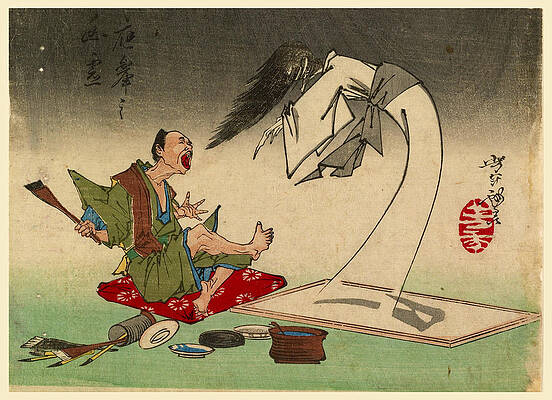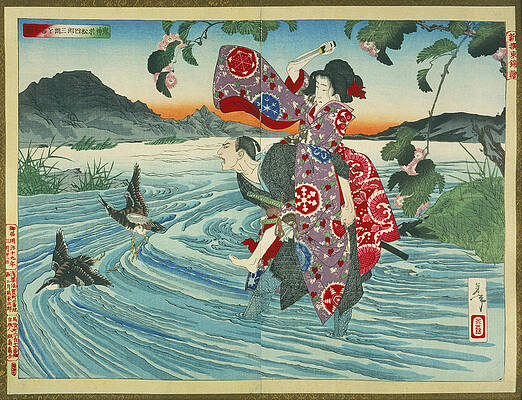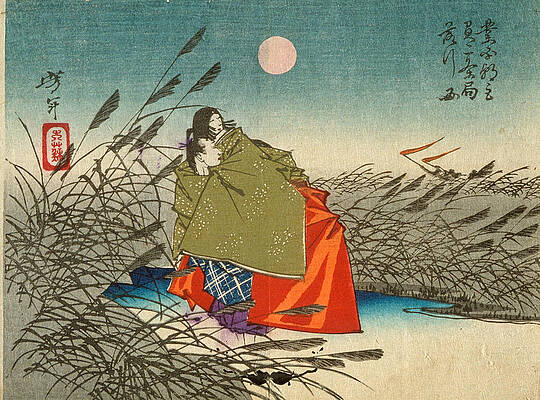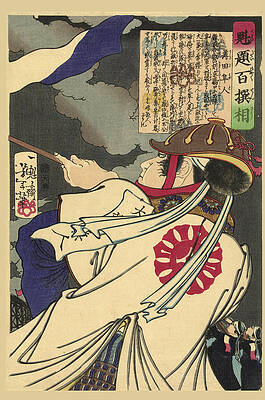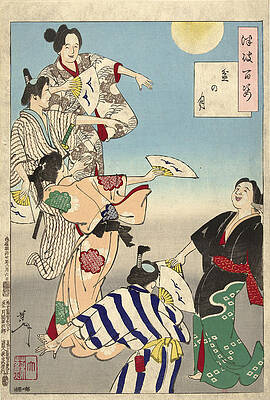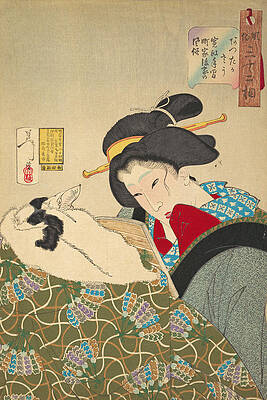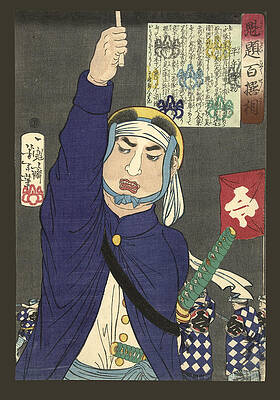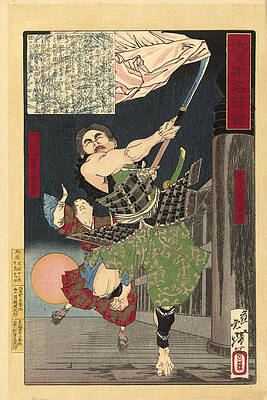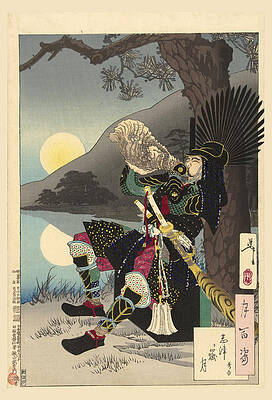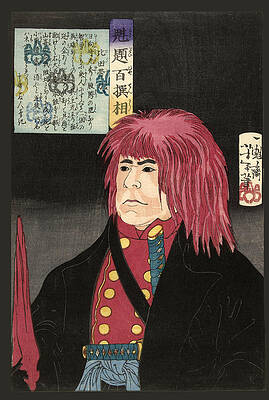Tsukioka Yoshitoshi
Yoshitoshi ryakugaed
The moon on Musashi Plain . Musashino no tsuki
The Demon Omatsu Murders Shirosaburo in the Ford
Narihira and Nijo no Tsubone at the Fuji River
Susukida Hayato waving a flag
Teasing the Cat
The moon of the Bon festival
Feeling Warm
Hirate Kenmotsu, raising a staff
Benkei, seen from the back, reading a hand roll
Yoshitsune and Benkei on the Gojo bridge
The moon over the village Chofu
Hideyoshi and the moon at Shizugatake
Hida no Tatewaki
Sono no Goro riding to Oiso without a saddle
Moon in the Flame

Rising Moon Over Mount Nanping (Nanpiezan shogetsu)
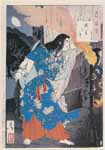
Moon of the Enemy's Lair (Zokusa no tsuki)

The Yugao Chapter From The Tale Of Genji (Genji yugao no maki)

Received Back into Moon Palace (Gekkyu no mukae)

Farmers Celebrating The Autumn Moon

Musashi Plain Moon (Musashino no tsuki)

Moon of the Red Cliffs (Sekiheki no tsuki)

In The Moonlight Under The Trees Comes a Beautiful Woman (Getsumai rinka bijin majiru)

Saga Moor Moon (Sagano no tsuki)

Grave Marker Moon (Sotoba no tsuki)

Horin Temple Moon (Horinji no tsuki)

Moon Of Enlightenment (Godo no tsuki)

Moon Of Insanity (Tsuki no monogurui)

Kinto Picks a Plum Branch In The Moonlight

The Moon's Four Strings (Tsuki no yotsu no o)

Suzaku Gate Moon (Suzakumon no tsuki).

Reading By The Moon (Dokusho no tsuki)

Kitayama Moon (Kitayama no tsuki)

Chang E Flees to the Moon (Joga hogetsu tsuki)

Ishiyama Moon (Ishiyama no tsuki)

Moon On The Southern Sea (Nankai no tsuki)

Huai River Moon (Waisui no tsuki)

Seson Temple Moon (Sesonji no tsuki).

Chinese Beauty Holding a Stringed Instrument

Sumiyoshi Full Moon (Sumiyoshi no meigetsu)

The Moon Through a Crumbling Window (Haso no tsuki)

Mount Yoshino Midnight Moon (Yoshinoyama yowa no tsuki)

Lady Chiyo and The Broken Water Bucket.

Michizane Composes a Poem by Moonlight

A Buddhist Monk Receives Seeds On a Moonlit Night (Bonso tsukiyo ni keishi o uku)


The Moon of the Milky Way (Ginga no tsuki)


Cassia Tree Moon (Tsuki no katsura)

Akazome Emon Viewing The Moon From Her Palace Chambers)

Lady Gosechi (Gosechi no myobu)

Moon of the Filial Son (Koshi no tsuki)

Moon Of Kintoki's Mountain (Kintokiyama no tsuki)

The Village of the Shi Clan On a Moonlit Night (Shikason tsukiyo)


Akashi Gidayu writing his death poem before comitting Seppuku












































Tsukioka Yoshitoshi (Japanese: 月岡 芳年; also named Taiso Yoshitoshi 大蘇 芳年; 30 April 1839 – 9 June 1892) was a Japanese artist.[1]
He is widely recognized as the last great master of the ukiyo-e genre of woodblock printing and painting. He is also regarded as one of the form's greatest innovators. His career spanned two eras – the last years of Edo period Japan, and the first years of modern Japan following the Meiji Restoration. Like many Japanese, Yoshitoshi was interested in new things from the rest of the world, but over time he became increasingly concerned with the loss of many aspects of traditional Japanese culture, among them traditional woodblock printing.
By the end of his career, Yoshitoshi was in an almost single-handed struggle against time and technology. As he worked on in the old manner, Japan was adopting Western mass reproduction methods like photography and lithography. Nonetheless, in a Japan that was turning away from its own past, he almost singlehandedly managed to push the traditional Japanese woodblock print to a new level, before it effectively died with him.
His life is perhaps best summed up by John Stevenson:
Yoshitoshi's courage, vision and force of character gave ukiyo-e another generation of life, and illuminated it with one last burst of glory.
—John Stevenson, Yoshitoshi's One Hundred Aspects of the Moon, 1992
His reputation has only continued to grow, both in the West, and among younger Japanese, and he is now almost universally recognized as the greatest Japanese artist of his era.
Biography: The early years
100 Aspects of the Moon #7, "Inaba Mountain Moon" The young Toyotomi Hideyoshi leads a small group assaulting the castle on Inaba Mountain (1885).
Yoshitoshi was born in the Shimbashi district of old Edo, in 1839. His original name was Owariya Yonejiro. His father was a wealthy merchant who had bought his way into samurai status. At the age of three years, Yoshitoshi left home to live with his uncle, a pharmacist with no son, who was very fond of his nephew. At the age of five, he became interested in art and started to take lessons from his uncle. In 1850, when he was 11 years old, Yoshitoshi was apprenticed to Kuniyoshi, one of the great masters of the Japanese woodblock print. Kuniyoshi gave his apprentice the new artist's name "Yoshitoshi", denoting lineage in the Utagawa School. Although he was not seen as Kuniyoshi's successor during his lifetime, he is now recognized as the most important pupil of Kuniyoshi.
Tokaido Meisho no Uchi, "Maisaka", early Yoshitoshi seascape design from a collaborative series (1863).
During his training, Yoshitoshi concentrated on refining his draftsmanship skills and copying his mentor’s sketches. Kuniyoshi emphasized drawing from real life, which was unusual in Japanese training because the artist’s goal was to capture the subject matter rather than making a literal interpretation of it. Yoshitoshi also learned the elements of western drawing techniques and perspective through studying Kuniyoshi’s collection of foreign prints and engravings.
Yoshitoshi's first print appeared in 1853, but nothing else appeared for many years, perhaps as a result of the illness of his master Kuniyoshi during his last years. Although his life was hard after Kuniyoshi's death in 1861, he did manage to produce some work, 44 prints of his being known from 1862. In the next two years he had sixty-three of his designs, mostly kabuki prints, published. He also contributed designs to the 1863 Tokaido series by Utagawa School artists organized under the auspices of Kunisada.
The "Bloody Prints": capturing the public imagination
Many of Yoshitoshi's prints of the 1860s are depictions of graphic violence and death. These themes were partly inspired by the death of Yoshitoshi's father in 1863 and by the lawlessness and violence of the Japan surrounding him, which was simultaneously experiencing the breakdown of the feudal system imposed by the Tokugawa shogunate, as well as the impact of contact with Westerners. In late 1863, Yoshitoshi began making violent sketches, eventually incorporated into battle prints designed in a bloody and extravagant style. The public enjoyed these prints and Yoshitoshi began to move up in the ranks of ukiyo-e artists in Edo. With the country at war, Yoshitoshi’s images allowed those who were not directly involved in the fighting to experience it vicariously through his designs. The public was attracted to Yoshitoshi’s work not only for his superior composition and draftsmanship, but also his passion and intense involvement with his subject matter. Besides the demands of woodblock print publishers and consumers, Yoshitoshi was also trying to exorcise the demons of horror that he and his fellow countrymen were experiencing.
Eimei nijūhasshūku (Twenty-eight famous murders with verse, 1867)
As he gained notoriety, Yoshitoshi was able to have ninety-five more of his designs published in 1865, mostly on military and historical subjects. Among these, two series would reveal Yoshitoshi’s creativity, originality, and imagination. The first series, Tsūzoku saiyūki (“A Modern Journey to the West”), is about a Chinese folk-hero. The second, Wakan hyaku monogatari (“One Hundred Stories of China and Japan”), illustrates traditional ghost stories. His imaginative prints set him apart from any other artist of the time.
"Seiriki Tamigorō committing suicide" from Kinsei kyōgiden series (1865).
Between 1866 and 1868 Yoshitoshi created some extremely disturbing images, notably in the series Eimei nijūhasshūku (“Twenty-eight famous murders with verse”). These prints show killings in very graphic detail, such as decapitations of women with bloody handprints on their robes.[2] Other examples can be found in the strange figures of the 1866 series Kinsei kyōgiden, (“Biographies of Modern Men”), which depicted the power struggle between two gambling rings, and the 1867 series Azuma no nishiki ukiyo kōdan. In 1868, following the Battle of Ueno, Yoshitoshi made the series Kaidai hyaku sensō in which he portrays contemporary soldiers as historical figures in a semi-western style, using close-up and unusual angles, often shown in the heat of battle with desperate expressions.
It is said that Yoshitoshi's work of the "bloody" period has had an impact on writers such as Jun'ichirō Tanizaki (1886–1965) as well as artists including Tadanori Yokoo and Masami Teraoka. Although Yoshitoshi made a name for himself in this manner, the "bloody" prints represent only a small portion of his work. They tend to be over-emphasized by critics, which has led to an inaccurate perception that overlooks the true variety, subtlety and insight of Yoshitoshi’s art.
The middle years: hard times and resurrection
From Yoshitoshi's series of beautiful women Shinryu nijushi toki (1880).
By 1869, Yoshitoshi was regarded as one of the best woodblock artists in Japan. However, shortly thereafter, he ceased to receive commissions, perhaps because the public were tired of scenes of violence. By 1871, Yoshitoshi became severely depressed, and his personal life became one of great turmoil, which was to continue sporadically until his death. He lived in appalling conditions with his devoted mistress, Okoto, who sold off her clothes and possessions to support him. At one point they were reduced to burning the floor-boards from the house for warmth. It is said that in 1872 he suffered a complete mental breakdown after being shocked by the lack of popularity of his recent designs.
In the following year his fortunes turned, when his mood improved, and he started to produce more prints. Prior to 1873, he had signed most of his prints as "Ikkaisai Yoshitoshi". However, as a form of self-affirmation, he at this time changed his artist name to "Taiso" (meaning "great resurrection"). Newspapers sprung up in the modernization drive, and Yoshitoshi was recruited to produce "news nishikie". These were woodblock prints designed as full-page illustrations to accompany articles, usually on lurid and sensationalized subjects such as "true crime" stories. Yoshitoshi's financial condition was still precarious, however, and in 1876, his mistress Okoto, in a gesture of devotion, sold herself to a brothel to help him.
Design from Yoshitoshi's well-known series of beautiful women Fuzoku Sanjuniso (1888).
With the Satsuma Rebellion of 1877, in which the old feudal order made one last attempt to stop the new Japan, newspaper circulation soared, and woodblock artists were in demand, with Yoshitoshi earning much attention. In late 1877, he took up with a new mistress, the geisha Oraku; like Okoto, she sold her clothes and possessions to support him, and when they separated after a year, she too hired herself out to a brothel. Yoshitoshi's works gave him more public recognition, and the money was a help, but it was not until 1882 that he was secure.
The Lonely House on Adachi Moor (1885)
A series of bijin-ga designed in 1878 entitled Bita shichi yosei caused political trouble for Yoshitoshi because it depicted seven female attendants to the Imperial court and identified them by name, it may be that the Empress Meiji herself was displeased with this fact and with the style of her portrait in the series.
In 1880, he met another woman, a former geisha with two children, Sakamaki Taiko. They were married in 1884, and while he continued to philander, her gentle and patient temperament seems to have helped stabilize his behaviors. One of Taiko's children, adopted as a son, became Yoshitoshi's student, and was thence known as Tsukioka Kōgyo.[1]
Yoshitoshi's notorious, yet compelling, “Oshu adachigahara hitotsuya no zu” (The Lonely House on Adachi Moor) appeared in 1885. This macabre work is iconic in its own right, and influential in the history of modern kinbaku, in that Itoh Seiu was fascinated by Yoshitoshi's accurate depiction of sakasa zuri (upside down suspension).
An 1885 issue of the art and fashion magazine "Tokyo Hayari Hosomiki" ranked Yoshitoshi as the number-one ukiyo-e artist, ahead of his Meiji contemporaries such as Utagawa Yoshiiku and Toyohara Kunichika. Thus he had achieved great popularity and critical acclaim.
By this point, the woodblock industry was in severe straits. All the great woodblock artists of the early part of the century, Hiroshige, Kunisada, and Kuniyoshi, had died decades earlier, and the woodblock print as an art form was dying in the confusion of modernizing Japan.
Yoshitoshi insisted on high standards of production, and helped save it temporarily from degeneracy. He became a master teacher and had notable pupils such as Toshikata Mizuno, Toshihide Migita, and others.
Later years: the eclipse of ukiyo-e
His last years were among his most productive, with his great series One Hundred Aspects of the Moon (1885–1892), and New Forms of Thirty-Six Ghosts (1889–1892), as well as some masterful triptychs of kabuki theatre actors and scenes.
From Yoshitoshi's Tsuki hyakushi ("One hundred aspects of the moon").
During this period he also cooperated with his friend, the actor Ichikawa Danjūrō, and others, in an attempt to preserve some of the traditional Japanese arts.
In his last years, his mental problems started to recur. In early 1891 he invited friends to a gathering of artists that did not actually exist, but rather turned out to be a delusion. His physical condition also deteriorated, and his misfortune was compounded when all of his money was stolen in a robbery of his home. After more symptoms, he was admitted to a mental hospital. He eventually left, in May 1892, but did not return home, instead renting rooms.
He died three weeks later in a rented room, on June 9, 1892, from a cerebral hemorrhage. He was 53 years old. A stone memorial monument to Yoshitoshi was built in Higashi-okubo, Tokyo, in 1898.
holding back the night
with its increasing brilliance
the summer moon
– Yoshitoshi's death poem[3]
Retrospective observations
Design from Yoshitoshi's series Shinkei Sanjurokuten (36 Ghosts), "Priest Raigo of Mii Temple" (1891).
During his life he produced many series of prints, and a large number of triptychs, many of great merit. Two of his three best-known series, the One Hundred Aspects of the Moon and Thirty-Six Ghosts, contain numerous masterpieces. The third, Thirty-Two Aspects of Customs and Manners, was for many years the most highly regarded of his work, but does not now have that same status. Other less-common series also contain many fine prints, including Famous Generals of Japan, A Collection of Desires, New Selection of Eastern Brocade Pictures, and Lives of Modern People.
While demand for his prints continued for a few years, eventually interest in him waned, both in Japan, and around the world. The canonical view in this period was that the generation of Hiroshige was really the last of the great woodblock artists, and more traditional collectors stopped even earlier, at the generation of Utamaro and Toyokuni.
However, starting in the 1970s, interest in him resumed, and reappraisal of his work has shown the quality, originality and genius of the best of it, and the degree to which he succeeded in keeping the best of the old Japanese woodblock print, while pushing the field forward by incorporating both new ideas from the West, as well as his own innovations.
Print series
Here is a partial list of his print series, with dates:
One Hundred Stories of Japan and China (1865–1866)
Biographies of Modern Men (1865–1866)
Twenty-Eight Famous Murders with Verses (1866–1869)
One Hundred Warriors (1868–1869)
Biographies of Drunken Valiant Tigers (1874)
Mirror of Beauties Past and Present (1876)
Famous Generals of Japan (1876–1882)
A Collection of Desires (1877)
Eight Elements of Honor (1878)
Twenty-Four Hours with the Courtesans of Shimbashi and Yanagibashi (1880)
Warriors Trembling with Courage (1883–1886)
Yoshitoshi Manga (1885–1887)
One Hundred Aspects of the Moon (1885–1892)
Personalities of Recent Times (1886–1888)
Thirty-Two Aspects of Customs and Manners (1888) "Fuzoku sanjuniso – Aitasou"
New Forms of Thirty-Six Ghosts (1889–1892)
See also
Night in paintings (Eastern art), including One Hundred Aspects of the Moon
References
Nussbaum, Louis Frédéric. (2005). "Tsukoka Kōgyō" in Japan Encyclopedia, p. 1000.
Forbes, Andrew ; Henley, David (2012). 28 Famous Murders. Chiang Mai: Cognoscenti Books. ASIN: B00AGHJVOS
Stevenson, John (1992). Yoshitoshi's One Hundred Aspects of the Moon. San Francisco Graphic Society. p. 49. ISBN 0-9632218-0-9.
Further reading
Eric van den Ing, Robert Schaap, Beauty and Violence: Japanese Prints by Yoshitoshi 1839–1892 (Havilland, Eindhoven, 1992; Society for Japanese Arts, Amsterdam) is the standard work on him
Forbes, Andrew ; Henley, David (2012). Forty-Seven Ronin: Tsukioka Yoshitoshi Edition. Chiang Mai: Cognoscenti Books. ASIN: B00ADQGLB8
Forbes, Andrew ; Henley, David (2012). 28 Famous Murders. Chiang Mai: Cognoscenti Books. ASIN: B00AGHJVOS
Shinichi Segi, Yoshitoshi: The Splendid Decadent (Kodansha, Tokyo, 1985) is an excellent, but rare, overview of him
T. Liberthson, Divine Dementia: The Woodblock Prints of Yoshitoshi (Shogun Gallery, Washington, 1981) contains small illustrations of many of his lesser works
John Stevenson, Yoshitoshi's One Hundred Aspects of the Moon (San Francisco Graphic Society, Redmond, 1992)
John Stevenson, Yoshitoshi's Women: The Print Series 'Fuzoku Sanjuniso' (Avery Press, 1986)
John Stevenson, Yoshitoshi's Thirty-Six Ghosts (Weatherill, New York, 1983)
John Stevenson, Yoshitoshi’s Strange Tales (Amsterdam. Hotei Publishing 2005).
----
Fine Art Prints | Greeting Cards | Phone Cases | Lifestyle | Face Masks | Men's , Women' Apparel | Home Decor ...
----
Artist
A - B - C - D - E - F - G - H - I - J - K - L - M -
N - O - P - Q - R - S - T - U - V - W - X - Y - Z
Retrieved from "http://en.wikipedia.org/"
All text is available under the terms of the GNU Free Documentation License


